A Program of Mulch Independence
Developing ways of meeting a core need within our growing systems
– April 3rd, 2017 –
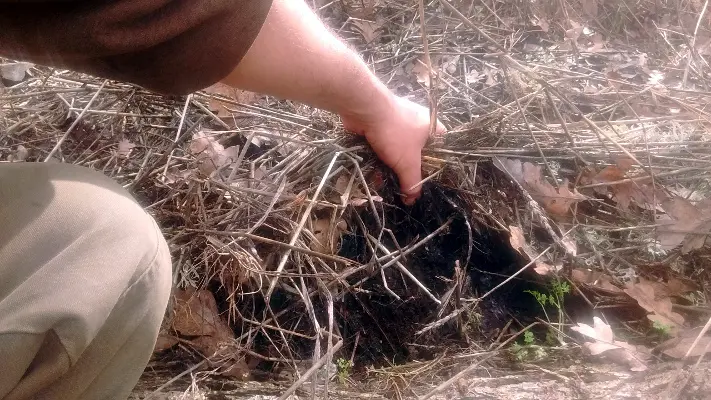
A thick layer of home grown wheat mulch
Why is mulch important?
No matter what climate one is trying to grow plants within, keeping the soil covered by a layer of organic material is an important practice.
Mulch provides shelter for the delicate soil ecosystem all of us should be wanting to foster. Solar radiation can cause soil to loose organic material, causing soil to both loose it’s structure and to dry out.
Mulch also moderates soil temperature, sheltering it from extremes in both highs and lows. Cooler soils loose less moisture, in addition to soil organisms preferring a soil temperature around 55 degrees.
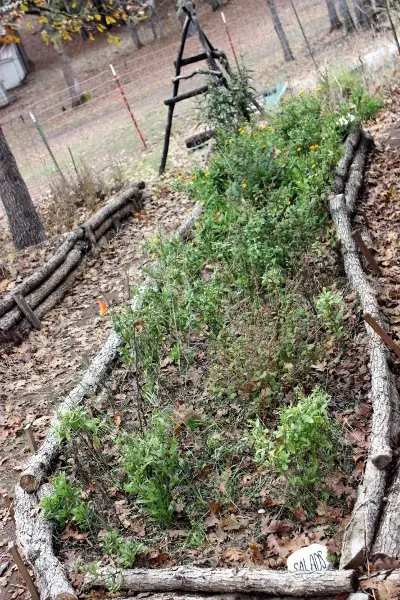
A mature, self-mulching mix of elderberry, lemon balm, mint, calendula, turnip and alfalfa
Towards a Mulch Independence
Most people do not think twice about purchasing organic material. Those in urban areas may have access to municipal wood chippings, scrap cardboard, or other industrial waste-stream products suitable for mulch.
Those living in agricultural areas may have easy access to crop residues, grass and legume hay.
Since Windward is located in a relatively isolated area, out of “easy” reach of both agricultural and urban resource streams, our need to develop systems and practices which enable us to produce our own mulch have become increasingly apparent.
Over the last two years we have begun implementing mulch production techniques through both cover-cropping and inter-cropping within our no-till annual garden and our hugelkultur “woodland garden”.
Previous Years Experiments
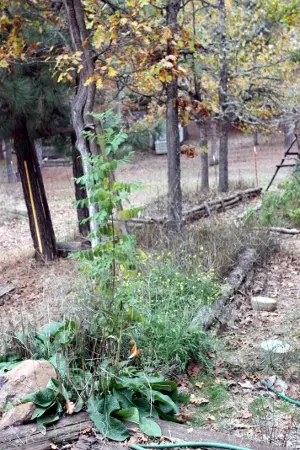
Black locust, comfrey and Turkish rocket planted into a thick residue from a wheat cover crop
Last year, many new beds were created in the front of Windward’s main dining hall and planted with a mixture of productive full-sized trees (apples, apricots, pear, black locust, honey locust, and elder berry) as well perennial greens such as Turkish rocket (a perennial arugula), Windward kale (open pollinated land race), and Swiss chard.
Many of the beds were also set aside their first year to just grow a heavy seeding of soft white winter wheat, a locally produced, non-irrigated crop which is very tolerant of cold temperatures. Thus, it can be fall seeded—staying green under the winter snow—and shoot up quickly in early spring when moisture is readily available. Winter wheat competes well with weeds and produced a large swathe of carbon-rich mulch that can help set up the beds with an initial layer of several inches of mulch.
The goal was to grow a large quantity of mulch the first year to help provide deep soil cover for the first few years as the rest of the garden plants fill in and begin providing mulch themselves. I think we achieved this well, and it has spurred more utilization of this species and technique in other areas.
Growing Mulch in the Annual Garden

A pan of the main annual garden
We are in the process of turning what has been a relatively conventional high-intensity annual garden into a mixed annual and perennial no-till garden that is more specifically managed for low-input production of staple crops such as potatoes, garlic, and root crops.
This garden transformation is occurring for a few reasons.
A primary goal of our research efforts are to develop system, strategies, and techniques which give good yields while requiring the minimal amount of the three W’s—Work, Water, and Worry.
Our experience in the annual garden growing a variety of crops has ultimately led us to the conclusion that high intensity gardening on a community scale is hard, given our climate. Cold spring temperatures and a 6 month frost period mean we do not plant much of the summer crops until mid May.
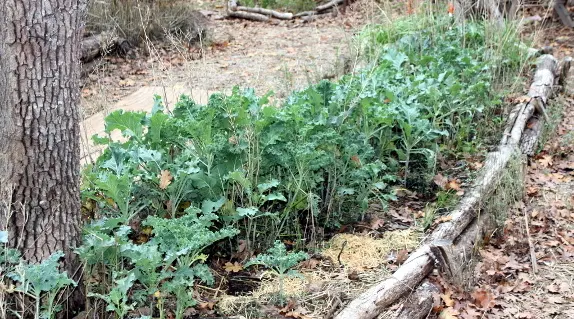
Kale beds near the front door of the dining hall. Very easy to tend and harvest all summer.
The Summers here are very warm, with daytime temps routinely in the 90s and often in the triple digits. We also receive little to no functional precipitation through the 6 month frost free growing season. This means that when the plants need the most water is also a time of year when we have to provide all the water for the garden.
Deep mulch beds help to ensure any water we do apply is well utilized by the system. However, on the scale that we are working, the annual garden requires more water and time than we typically have available through the otherwise busy summer months.
Because of this, we are constantly trying to maximize productivity in relation to the amount of inputs we have to provide for the system. Inputs include work, water, and worry.
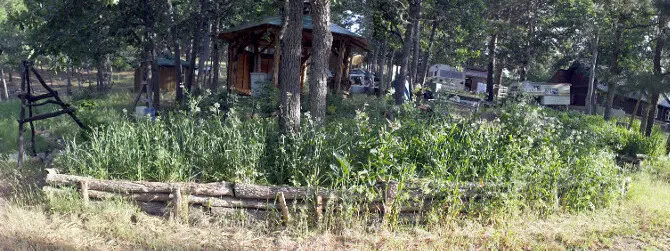
Leafy greens growing in with a thick layer of home grown wheat mulch
The location of the garden is rather far from our community’s dining hall, the hub of most of our activities. Physically walking to the garden and back to check on more tender plants such as tomatoes or peppers takes time and effort which could otherwise be spent expanding the community’s systems and options as opposed to maintaining something we already have.
We are now transitioning what has been the main annual garden to produce the crops that work really well in our climate, and require a minimal amount of work, water and worry.
We are transitioning this garden to focus on those plants, as we move plants which “produce more the more we harvest and tend to them” into a new garden space being developed in front of the dining hall and in the large earth sheltered greenhouse which is currently under construction.
This year we will be trying to grow fewer individual “needy” plants (such as tomatoes), and giving each individual plant more resources (fertility and water) in order to maximize the productivity of every individual plant. What this looks like is growing tomatoes and peppers in 25 gallon containers that are placed right outside the dining hall’s door. These container plants will be able to receive grey water from the dining hall, and will be given liquid fertilization through the summer months to ensure they have all the fertility they need to thrive.
In the main annual garden, we are transitioning to a crop rotation system—growing mulch and fertility for this system within the system. This year, half of the main annual garden will be planted in “production crops” within in a deep-mulch minimal till type system.
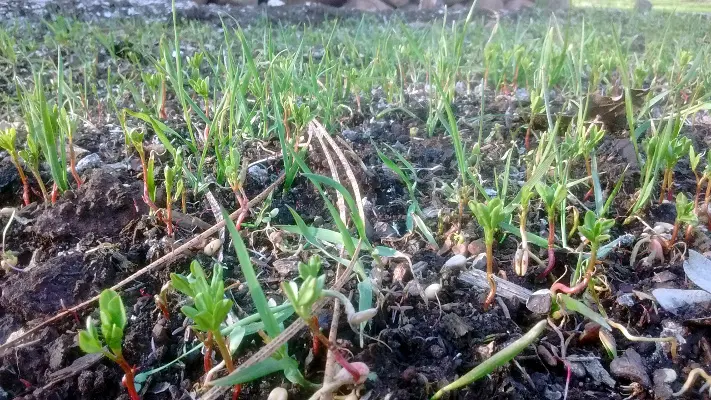
Wheat and lentil cover crop springing up this year on a new terrace
The other half will be planted in a non-irrigated cover crop mix intended to provide both nitrogen fertility, as well as a large quantity of persistent (i.e. carbon rich) mulch—as well as some annual flowers to support pollinators and beneficial insects.
The primary species we’re growing as a cover crops in the annual garden include:
- Soft white winter wheat: a local crop that creates a high-carbon mulch.
- Hairy Vetch: a common and cold tolerant legume, fall seeded with the winter wheat.
- Buckwheat: a common cover crop, it is included in lesser quantities primarily because of it’s long flowering times and high nectar production for our honey bees.
- Calendula, Marigolds, Red clover, Radish, Turnip: all of these plants have proven to grow well in the margins of the garden and provide both insectary and soil building benefits.
Growing Mulch on Hugelkultur Beds and Terraces.
We recently had a great spring permaculture course out on the land. One of the projects was the creation of another contour hugelkultur bed on our main hillside. The newest in a series of large hugelkultur beds that have been taking shape as the “skeleton” of our young woodland garden.
We heavily seeded the hugelkultur bed with both Wheat and Lentils as a primary mulch and soil building cover crop for the first year.
The bed was seeded very heavily with both of these species to ensure good spread and germination in the face the impact of birds and other critters eating the seed.
To help speed germination, the wheat and lentils were soaked in water for 24 hours to ensure they had all the water they needed for germination before they were seeded into the beds.
Deep Mulched Swale Paths Between Terraces
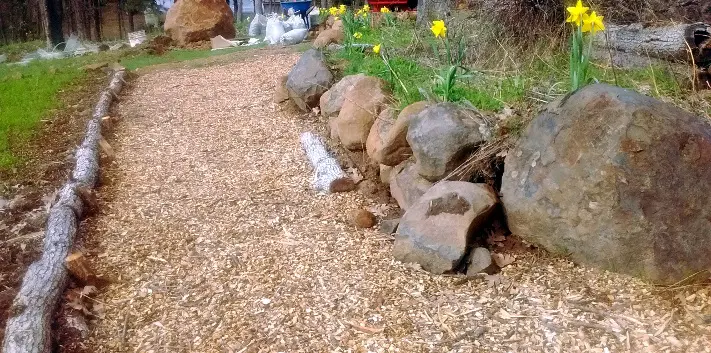
Woodchip mulched swale paths
One of the design priorities of Windward’s main hillside is to clearly delineate growing space from walking paths. We also need to build up the fertility and organic material of the soil, typically through incorporating decaying woody biomass into the lower reaches of the bed.
We are creating level areas to capture rainfall and snow melt, as well as level areas to grow gardens which require more tending and seeding. Hugelkultur beds are great in many respects, but their steep sides are hard to seed, plant, and irrigate if need be. When working with annuals, this makes traditional “rough” hugelkultur not a great option.
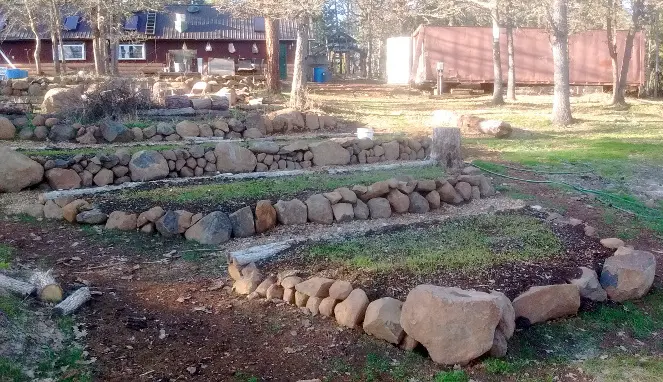
A view of a few rock wall terraces built in this fashion
Because of this, and because of our desire to move more intense annual production closer to the kitchen, we have struck upon a design for rock wall “buried wood” terraces delineated by generous deep mulch wheelbarrow-sized contour paths. This design is both beautiful and works extremely well to promote all the above mentioned goals simultaneously.
The mulch we’re using for the paths are wood chips generated from the ongoing forestry at Windward. It makes great mulch for paths, as it disperses the weight of people walking on it. It also decomposes relatively slowly, particularly when the sod and top soil are removed from the paths (and incorporated into the grow beds) before it is laid down in the paths.
Bark Mulch from Sawmill
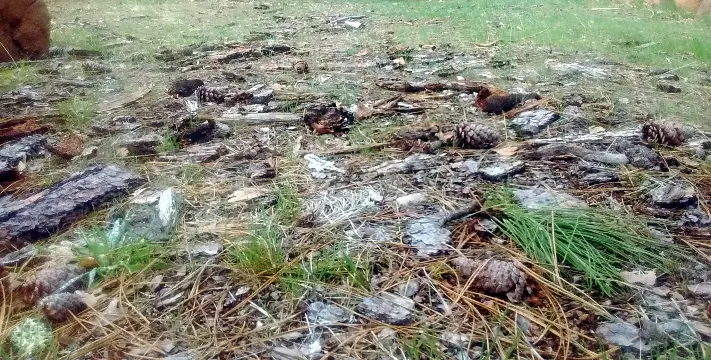
Bark mulch from Windward’s sawmill in an open gathering space
Bark mulch is not very good “food” for the soil in the same way that wood chips, straw or other organic material is. That is because bark has very little energy in it and is mostly composed of ash. Bark does not decompose quickly, persisting on the ground for a much longer periods.
The goal for these open spaces is not to intensively grow plants, but instead to be used for community gathering space, areas to set up solar cookers and dehydrators, and to temporarily store materials such as compost and mulch.
The bark helps to provide cover to the soil which keep the mud and dust to a minimum, while also discouraging vegetation and minimizing the compaction of the soil by constant foot traffic.
